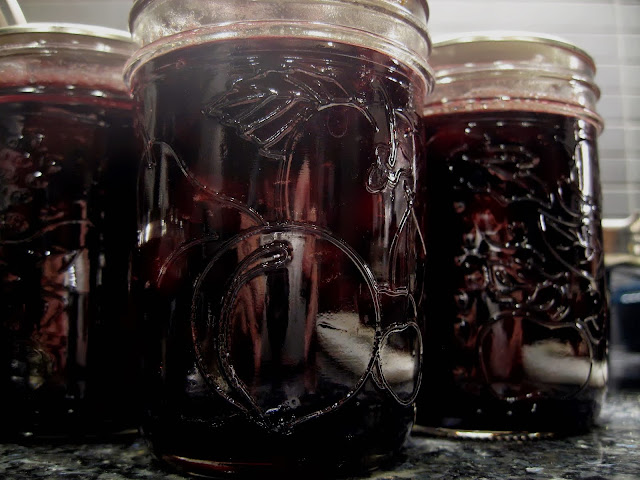This is the week when canning buddy and I hit the pick-your-own farm and come back in a car that smells like summer. Then we race to turn the soft fruit (usually strawberries and raspberries, sometimes currants and cherries as well) into countless jars of jam in the hope that it will remind us of summer right through a Canadian winter.

But I’ve written about the summer can-o-rama before, and there’s a limit to how many times you I can brag about how many jars of jam we made (44 this year). I want to opine instead on the pectin problem, given that strawberries don’t have enough of it for a jam to set, and strawberry jam is up there on the list of must-have jars.
I am not a fan of how regular commercial pectin gives my jam a gelatinous feel, so I’m always in the market for a workaround. The addition of a kiwi fruit, recommended by the New York Times a few years back, produces a nice, soft strawberry jam, although you have to be careful to remove all the kiwi’s woody core, and the black seeds are mildly disconcerting, a gentle reminder that it’s not all strawberry. Other recipes suggest adding an apple (I tried that with a cherry jam one year and it ended up like cherry jam with apple sauce), and last month I hit the jackpot by adding home-made crabapple pectin to a strawberry jam, which produced a genuinely “wow” jam, which might be one of the best I’ve ever made.
But I’m out of crabapple pectin. In the course of a mad canning afternoon, we tried out four alternatives, all of which seem to work around the strawberry-set problem. I’ll add the ratings when I get round to opening the jars.
1. Strawberry jam with Pomona pectin.
I’ve read a lot about Pomona pectin on the interwebz, and fans say it offers the set without the sour, so you don’t need as much sugar and you don’t cook your jam as long. It’s a U.S. product, so I was sort of surprised to see it at the local health food store. Expensive, yes, but worth a go.

Because it was the first time, we followed the recipe pretty slavishly for this one, mixing one of the two packets in the box to produce a calcium water, and then stirring the recommended volume of the pectin packet into the sugar before adding sugar/pectin to hot strawberries and boiling for another 1-2 minutes. It all seemed pretty vague — between 3/4 of a cup and two cups of sugar to four cups of mashed up strawberries — and Pomona said firmly that strawberries didn’t need the addition of lemon juice. But it was definitely worth a try.
It’s early days, but while the set was firm (too firm, perhaps?) I do admit the first taste was not as truly yummy as I thought it ought to be. Maybe strawberry jam needs the bitterness of lemon to bring out the strawberries? Or maybe 2-1/2 cups of sugar to 8 cups of fruit just wasn’t quite enough? We have eight jars. It’s still strawberry jam.
2. Strawberry-raspberry jam
Second workaround was one we’ve used many times before, mixing strawberries with pectin-rich raspberries (and lemons) for glorious burst of flavour. The first taste is raspberry, but then the strawberry creeps through, and it’s always a lovely set. We make this jam each year. No reason to stop now.
3. Strawberry-gooseberry jam
Recipe number 3 swapped out raspberries for gooseberries, which have even more pectin than raspberries do. And while the strawberry-raspberry jam used 3 cups each of strawberries and raspberries, the strawberry-gooseberry one was a ratio of 5:1, with a little extra sugar to cut the gooseberry bite. Nice set. Taste rating to come.

4. Strawberry jam with gooseberry pectin
Then things got a little more experimental, and if the crabapple pectin worked so well, what about making a gooseberry pectin, which meant boiling the berries up with a little water, and then straining the juice out in a jelly bag. In an ideal world I’d have left the goop to drip overnight, but we wanted now. So we added two tablespoons of gooseberry pectin to 6 generous cups of strawberries, and jammed them up with 4 scant cups of sugar and the juice of two lemons. The taste is good. The gooseberry elixir adds a bitterness which I rather like, and you don’t have to top or tail the gooseberries, a sticky, frustrating and time-consuming task.
Plus there are 10 little ice cube trays of gooseberry pectin waiting for the next jam.
We got five jars of that jam, but one jar had an accident in the waterbath. It’s only the second time that’s ever happened. Too many jars in the canner? A flaw in the jar?
Who knows. It was almost the end of the session, so we abandoned the idea of waterbathing the last 7 jars of pure raspberry jam and retired to the Ribfest up the street.
Despite that broken jar, it was a seriously successful day.







